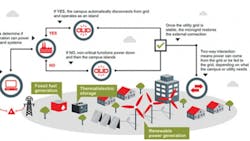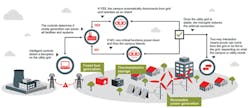Owners and operators of facilities or campuses in which a reliable power supply is critical are aware of the value of backup power generation, and many may be taking additional steps to ensure energy reliability. But they might not be aware of the benefits of creating a microgrid at their sites.
Microgrids are critical in ensuring energy reliability and security for military sites, federal, state and local government facilities, hospitals, data centers and research-driven universities. By going beyond simple, single-site backup generation to combine distributed generation, load management, and dynamic interaction with the utility, microgrids help organizations fortify energy infrastructure, improve reliability, and protect against broad disruptions on the main grid.
This is especially critical as our existing, aging electrical infrastructure continues to be overburdened—electricity demand increased by about 25 percent since 1990, while construction of transmission facilities decreased by about 30 percent. Further, the number and duration of weather-related power disruptions on the grid continues to rise, with the average annual outage duration in the United States hovering around 120 min. compared to an average of 10 min. for the rest of the industrialized world.
Microgrids have four distinct elements. The first is local, on-site power generation. This could be a combination of renewable-fuel- or fossil-fuel-based generation, such as a combined-heat-and-power (CHP) plant, a solar plant, or a wind- or geothermal-based power-generation system.
The second element is coexistence with the utility. Whatever the type, the local power generation system remains interconnected with the utility grid.
The third element of a microgrid is the ability to manage and control a facility’s load so the load and local generation can be shaped and matched.
The fourth element is the ability to separate or “island” from the utility. A facility or campus with a microgrid can operate with or without a utility.
What facilities would benefit from a microgrid?. Data centers, hospitals, military bases, and watewater treatment facilities, where energy surety is very important, typically are good candidates for microgrids, as are higher education campuses and laboratories in which critical research and experiments are conducted.
Four Steps to Implementation
There are four steps to implementing a microgrid at a facility or campus: make traditional energy-efficiency improvements, put on-site energy generation and storage in place, implement advanced controls, and set up a system with the local utility that creates the ability to separate from and join back to the utility grid. Here is a closer look at these four steps.
Make traditional energy-efficiency improvements. A key to creating a microgrid is determining how much energy is needed. A facility or campus only needs to generate or purchase the energy it requires. Therefore, making energy-efficiency improvements to minimize energy usage is the first step.
Look at traditional energy-efficiency-improvement measures, such as lighting retrofits, HVAC updates, overall building-management-system scheduling, building-envelope improvements, and continuous monitoring of operations to minimize or eliminate the amount of energy that is wasted.
Making as many energy efficiency improvements as possible also helps in properly sizing a microgrid.
Put on-site energy generation and storage in place. Many facilities already have some form of on-site generation. For example, many large universities have a central boiler or central utility plant to provide heat or heat and electricity.
Look at the existing system holistically, taking into account the total demand of the campus or building and how much of that demand the system could withstand if power delivery from the utility were lost. The power loss might be caused by a natural disaster, such as a hurricane or earthquake, or it may be a utility emergency caused by a peak-load event during hot summer weather. Either way, analyze what amount of load the campus can stand not being served. Determine the percentage of the campus’s load that is high-priority and always needs to be on and what percentage of the campus can manage without power for a short time.
Analyze the overall campus and then see if there is enough on-site generation and storage to meet the critical loads. There might already be enough. If there is not, consider adding more sustainable power sources, such as a biomass, solar, or high-efficiency CHP plant.
Be sure to consider the campus’s electrical and thermal storage. Many campuses have batteries to store electrical energy and thermal-storage capabilities that allow for storage of chilled water or ice made during the night, when energy typically is less expensive. Storage is important for renewable-energy sources, such as wind or solar, because the timing of the energy generation cannot be controlled—it will be generated when the sun is shining or the wind is blowing. Therefore, the ability to store the energy and reuse it later is crucial.
Implement advanced controls. A key element of a microgrid is tying together a campus’s power-generation system with the utility. The system design engineer should work with the utility to ensure maximum benefit to the campus and the utility. In many areas of the country, grid operators are wiling to provide incentives for particular load shifts. Utilities and independent-system operators often provide incentives for load shedding, shifting load from daytime to evening and reducing usage during times of peak demand.
On a broader scale, a campus that has excess power-generation capabilities could supply reserves for a utility. Many of these reserve programs provide incentives that make the microgrid a cash-flow item for an owner. To fully take advantage of the opportunities, however, advanced controls are needed. These include the ability to control the generation, storage, and loads of a campus, as well as the interconnection between the microgrid and the utility. This requires a well-defined interconnection, where the utility allows a bidirectional flow of power and provides signaling that lets a campus either send or receive power, depending on the grid condition.
Advanced controls also provide the ability to integrate various energy sources to best fit the needs of the building or campus owner.
Create the ability to isolate the microgrid from the utility. This is the fourth and final step to creating a full-fledged microgrid.
Imagine there is a major disturbance on the utility grid. In such an event, can a campus’s critical loads operate, using the campus’s own generation and storage, without having the utility be live on the other end? In a properly sized microgrid, the answer should be “yes,” but it needs an interconnection with the utility so the campus can isolate itself from the utility and operate on its own. A well-defined resynchronization procedure also is essential. All procedures for separating and rejoining the utility need to be well-defined and seamless.
A campus with a microgrid also could consider proactive separation as well. This may be an option when a large storm is approaching or when a utility’s load is very high on a hot summer day. Most utilities will pay facilities for helping them achieve grid stabilization.
Beyond Backup
Many facilities or campuses already have some elements of microgrids in place. But the owners and operators may not be aware of the entire scope of a microgrid. For example, they may not be aware of all the utility incentives that might be available for load shaping, load shifting, or demand-response operation. Also, they may not be aware they can separate from the utility and maintain their service level for certain critical loads without the utility being present. All of these capabilities are enabled by a microgrid, and they all serve to make the creation of a microgrid worthwhile to consider for facilities and campuses where energy reliability is vital.
Microgrid Sizing: Consider Growth, Usage Philosophy
When sizing a microgrid system for a campus, take the campus’s growth plans into account. If a campus is going to grow over the next five to 10 years, the local generation and storage capabilities should be sized to accommodate that growth.
Also, it is incumbent on the system design engineer to determine the customer’s overall philosophy of operating a microgrid. Is local generation going to be used most of the time and the utility used as a backup, or will the utility be the primary energy supplier, with local generation used as backup? Or is the microgrid going to be used to take advantage of all kinds of utility incentives and demand-side-management programs?
A holistic look at a customer’s overall philosophy of operating a microgrid is important to determine the amount of local generation and storage needed. It also is important to determine the correct fuel mix for local generation. In many areas, for example, a campus will not always be allowed to run diesel generators because of permitting requirements and environmental regulations. In those cases, a better choice for additional generation may be a natural-gas turbine or renewable sources such as solar, wind, or biomass.
Keep in mind that if a customer wants to use a campus’ microgrid to gain utility incentives, the ability to store the local power generated by solar or wind becomes crucial, as that power may be generated when utility rates are low or no demand-side incentives are available.
Datta Godbole, PhD, is vice president of engineering and chief technology officer for Honeywell Building Solutions.

